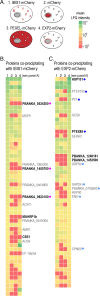A member of the tryptophan-rich protein family is required for efficient sequestration of Plasmodium berghei schizonts
- PMID: 36126089
- PMCID: PMC9524624
- DOI: 10.1371/journal.ppat.1010846
A member of the tryptophan-rich protein family is required for efficient sequestration of Plasmodium berghei schizonts
Abstract
Protein export and host membrane remodeling are crucial for multiple Plasmodium species to establish a niche in infected hosts. To better understand the contribution of these processes to successful parasite infection in vivo, we sought to find and characterize protein components of the intraerythrocytic Plasmodium berghei-induced membrane structures (IBIS) that form in the cytoplasm of infected erythrocytes. We identified proteins that immunoprecipitate with IBIS1, a signature member of the IBIS in P. berghei-infected erythrocytes. In parallel, we also report our data describing proteins that co-precipitate with the PTEX (Plasmodium translocon of exported proteins) component EXP2. To validate our findings, we examined the location of three candidate IBIS1-interactors that are conserved across multiple Plasmodium species, and we found they localized to IBIS in infected red blood cells and two further colocalized with IBIS1 in the liver-stage parasitophorous vacuole membrane. Successful gene deletion revealed that these two tryptophan-rich domain-containing proteins, termed here IPIS2 and IPIS3 (for intraerythrocytic Plasmodium-induced membrane structures), are required for efficient blood-stage growth. Erythrocytes infected with IPIS2-deficient schizonts in particular fail to bind CD36 as efficiently as wild-type P. berghei-infected cells and therefore fail to effectively sequester out of the circulating blood. Our findings support the idea that intra-erythrocytic membrane compartments are required across species for alterations of the host erythrocyte that facilitate interactions of infected cells with host tissues.
Conflict of interest statement
The authors have declared that no competing interests exist.
Figures





Similar articles
-
The PTEX Pore Component EXP2 Is Important for Intrahepatic Development during the Plasmodium Liver Stage.mBio. 2022 Dec 20;13(6):e0309622. doi: 10.1128/mbio.03096-22. Epub 2022 Nov 29. mBio. 2022. PMID: 36445080 Free PMC article.
-
The exported Plasmodium berghei protein IBIS1 delineates membranous structures in infected red blood cells.Mol Microbiol. 2012 Mar;83(6):1229-43. doi: 10.1111/j.1365-2958.2012.08004.x. Epub 2012 Feb 21. Mol Microbiol. 2012. PMID: 22329949 Free PMC article.
-
Trafficking of the signature protein of intra-erythrocytic Plasmodium berghei-induced structures, IBIS1, to P. falciparum Maurer's clefts.Mol Biochem Parasitol. 2015 Mar-Apr;200(1-2):25-9. doi: 10.1016/j.molbiopara.2015.04.005. Epub 2015 May 5. Mol Biochem Parasitol. 2015. PMID: 25956941
-
Plasmodium species: master renovators of their host cells.Nat Rev Microbiol. 2016 Aug;14(8):494-507. doi: 10.1038/nrmicro.2016.79. Epub 2016 Jul 4. Nat Rev Microbiol. 2016. PMID: 27374802 Review.
-
The role of the Maurer's clefts in protein transport in Plasmodium falciparum.Trends Parasitol. 2009 Jun;25(6):277-84. doi: 10.1016/j.pt.2009.03.009. Epub 2009 May 11. Trends Parasitol. 2009. PMID: 19442584 Review.
Cited by
-
The essential genome of Plasmodium knowlesi reveals determinants of antimalarial susceptibility.Science. 2025 Feb 7;387(6734):eadq6241. doi: 10.1126/science.adq6241. Epub 2025 Feb 7. Science. 2025. PMID: 39913579
-
The PTEX Pore Component EXP2 Is Important for Intrahepatic Development during the Plasmodium Liver Stage.mBio. 2022 Dec 20;13(6):e0309622. doi: 10.1128/mbio.03096-22. Epub 2022 Nov 29. mBio. 2022. PMID: 36445080 Free PMC article.
-
The Plasmodium GRASP Homolog Modulates Liver Stage Development, Subsequent Blood Infection and Virulence in Mice.Mol Microbiol. 2025 Jun;123(6):487-515. doi: 10.1111/mmi.15360. Epub 2025 Mar 26. Mol Microbiol. 2025. PMID: 40143578
-
Plasmodium falciparum CLAG Paralogs All Traffic to the Host Membrane but Knockouts Have Distinct Phenotypes.Microorganisms. 2024 Jun 8;12(6):1172. doi: 10.3390/microorganisms12061172. Microorganisms. 2024. PMID: 38930554 Free PMC article.
-
The structure of a Plasmodium vivax Tryptophan Rich Antigen domain suggests a lipid binding function for a pan-Plasmodium multi-gene family.Nat Commun. 2023 Sep 14;14(1):5703. doi: 10.1038/s41467-023-40885-8. Nat Commun. 2023. PMID: 37709739 Free PMC article.
References
Publication types
MeSH terms
Substances
LinkOut - more resources
Full Text Sources

